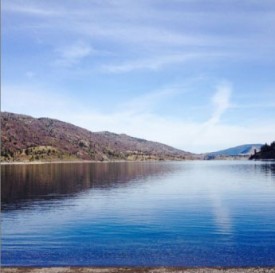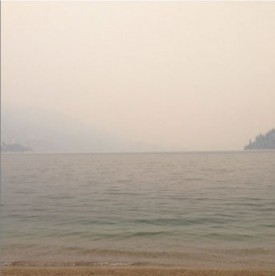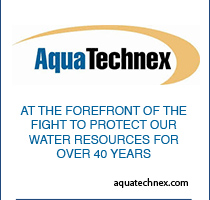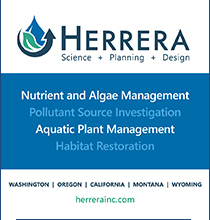
Omak Lake before Carlton Complex fires in 2014 (Photo: Amy Martin)
by Amy Martin
With high temperatures and drought contributing to two dangerous fire seasons in Washington in the last two years, wildfires are becoming more familiar to land managers east and west of the Cascades. During 2014 and 2015, wildfires in Washington burned nearly 1.5 million acres. The impacts of these fires on surface water resources will vary, but a detailed summary of the science by Anthony Ranalli of USGS (see references) provides some insight into what trends may be observed over the next few years if these conditions persist.

Omak Lake during the Carlton Complex fires in 2014 (Photo: Amy Martin)
Lake managers handling recreational, agricultural or drinking water resources are primarily interested in nutrient and sediment inputs. The delivery of nutrients and sediment from a burned landscape to surface water is influenced by several factors, including soil burn severity, topography and weather variables like wind and precipitation. One of the most important aspects is soil burn severity, which is a measure of the fire’s effect on the soil and ground cover. High severity burns bring higher concentrations of white ash and burned soil organic matter, which is more prone to erosion, overland flow, and leaching, while also being associated with low plant survival. Topography and weather influence erosion and air deposition of nutrients.
There is an important distinction between wildfire and prescribed fires – both on the ground and in the literature. Prescribed fires result in predominantly low soil burn severity, reducing understory vegetation and organic matter accumulated on the soil, without killing overstory vegetation or burning soil to ash. Wildfires tend to produce mixed severity burns that are much more likely to form ash and produce the effects described below.
Nitrogen
Post-fire, surface water concentrations of nitrate tend to spike within weeks or months, and then slowly decline. An initial peak is related to deposition from the air. Nitrogen volatilizes at a relatively low temperature (200°C) to ammonium, becoming airborne or depositing directly into surface water as organic matter combusts (smoke). Weather is influential at this point: ammonium is deposited directly to surface water (as airborne ash) or by precipitation, and travels by wind. Nitrification of ammonium produces the nitrate spike. This source of nitrogen can also be detected in adjacent watersheds; as we know, smoke ignores boundaries!
A later nitrate peak can occur from increased nitrification on the burned landscape, which will move more slowly than airborne nitrogen. The increase in nitrate may be observed for as many as eight years following a wildfire (Paige & Zygmunt). Nitrate levels gradually decline to normal as landscape vegetation recovers.
Phosphorus
The primary source of phosphorus in a burned watershed is the direct deposition of ash in surface water. Post-fire erosion and flooding can carry soil and ash (and anything in its path) to streams and lakes. Even in areas with few plants, leaching that occurs on burned uplands tends to be taken up by vegetation, minimizing phosphorus in surface water run-off. Phosphorus concentrations usually return to normal levels within a few years.
Erosion from upland landscapes and burned riparian areas can also increase turbidity and reduce the quality of aquatic habitat. While the increase in turbidity from airborne material or sediment tends to limit primary productivity initially, eventually the increase in nutrients can contribute to algal blooms. Oligotrophic or mesotrophic lakes will be most sensitive to increased nutrient inputs. In some cases, upland erosion can kill fish or drastically alter habitat.
Increased concentrations of dissolved organic carbon are a concern in drinking water sources. The chemicals used to treat drinking water can react with dissolved organic carbon and produce several toxins, including carcinogens (Writer & Murphy, 2012).
While fire is natural to many Washington landscapes, post-fire impacts can pose challenges for most public uses of natural resources. The research shows that the effects are relatively short-lived, and many studies show no impact to surface water resources at all, particularly when soil burn severity was low.
References:
- Paige, G. and Zygmunt, J. 2013 The Science Behind Wildfire Effects on Water Quality, Erosion, in Living With Wildfire in Wyoming. University of Wyoming Extension. Available at http://www.uwyo.edu/barnbackyard/_files/documents/resources/wildfire2013/waterqualityerosion2013 wywildfire.pdf
- Ranalli, A.J., 2004, A Summary of the Scientific Literature on the Effects of Fire on the Concentration of Nutrients in Surface Waters: U.S. Geological Survey Open-File Report 2004-1296, 23 p.
- Writer, J.H., and Murphy, S.F., 2012, Wildfire effects on source-water quality—Lessons from Fourmile Canyon fire, Colorado, and implications for drinking-water treatment: U.S. Geological Survey Fact Sheet 2012–3095, 4 p.









